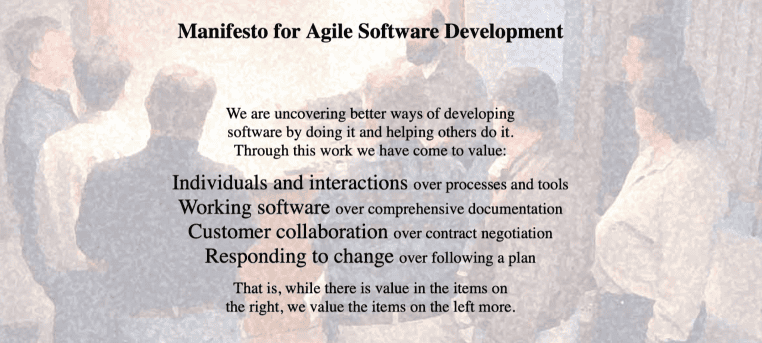
Agile teams are described as “self-organizing” or “self-managing.” But what does that really mean? The terms are frequently used but not widely understood. For teams to “be” Agile, they need to know how to act.
Behaviors describe actions. They are observable and universally evident to all team members. To “be” Agile, teams should identify and clearly label the desired actions and interactions. Clearly defining these traits establishes and communicates expectations.
The Agile Manifesto provides guidance on how teams should operate and work together to “be” Agile.
Agile Values & Principles
Agile is a mindset described by the four value statements and 12-principles of the Manifesto. The values set the objectives, and the principles describe how to instantiate them.
The magic of Agile teams is derived from these values:
- Individuals and interactions over processes and tools, and
- Customer collaboration over contract negotiation.
People are the heart of our projects. We must value our teams and customers. Create an open and safe environment where everyone feels respected.
Processes, tools, and agreements (contracts) are valuable. They create the structure and parameters that enable our teams. But they do not guarantee success.
The following five principles provide insight into how the behaviors of our high-performing Agile teams.
Principle #4) Business people and developers must work together daily throughout the project.
Daily engagement breaks down the silos that block collaboration. Silos exist across the entire value-delivery chain. Issues between business and technology drive customer dissatisfaction. Matrixed team silos within technology organizations create dysfunction and inefficiency.
Traditional teams have limited engagement creating an “us” versus “them” mentality. People feel misunderstood, which stokes the downward spiral of mistrust and frustration.
Working together daily changes that dynamic. People talk to each other. They ask questions and make fewer assumptions. They openly solicit input and candidly provide feedback. This seemingly small change has a significant impact.
Co-locating a business application owner with her development team dramatically changed the entire team dynamic. Before the Agile transformation, the application owner and the development team were frustrated and blamed each other. However, by working together, mistrust was replaced by mutual respect.
Principle #5) Build projects around motivated individuals. Give them the environment and support they need, and trust them to get the job done.
Factories and mass production dominated the landscape at the turn of the 20th century. Today, we are in the information age. Peter Drucker coined the term knowledge workers at the cusp of this change in the 1950s. This shift in the workplace required new management theories and practices.
Douglas McGregor’s Theory X and Y portrayed the old and new management styles. Theory X managers focus on oversight and control. Theory Y managers believe employees are internally motivated. Abraham Maslow added Theory Z managers who cultivate creativity.
David McLelland and Dan Pink described how intrinsic motivators drive the modern workforce. People want to feel that what they do matters. They want autonomy to decide how to do the work, and they want to feel part of a team.
Both data and experience demonstrate that the new role of management is to create an environment where teams can thrive. Where creativity and innovation are encouraged, people do their best work.
Principle #6) The most efficient and effective method of conveying information to and within a development team is face-to-face conversation.
People are hard-wired to communicate face-to-face. Over 90% of communication is non-verbal. Body language, facial expressions, and intonations convey most of the message.
When trying to solve and collaborate on complex problems, we should try to communicate in person—preferably around a whiteboard. The ability to visually depict ideas combined with the high fidelity of face-to-face increases understanding and improves collaboration.
Communicating electronically is not as effective. Studies show that negotiations conducted via email or phone are far less effective, and solicitations made in person are 34 times more successful than email. Video conferencing and collaboration tools are good but do not replicate the in-person experience—dialogue is replaced by a series of short monologues.
Principle #10) Simplicity–the art of maximizing the amount of work not done–is essential.
Eliminating waste is a core Lean principle adopted by Agile. When we simplify, we change the fabric and structure of our organizations and culture. Simplicity requires trust and empowerment.
Traditional management practices are highly structured, controlled, and complicated. People are organized into functional silos and disconnected from their work. All these practices are Agile anti-patterns.
Simplification democratizes the workplace. Teams are connected to their work and have control. They define and improve the process. They are empowered to solve problems and make decisions. These changes create personal commitment, ownership, and pride.
Principle #11) The best architectures, requirements, and designs emerge from self-organizing teams.
Traditional project management practices promote silos. Development is like a production line with role-specific specialists. Business analysts collect requirements, architects design, software engineers write code, and testers test.
This structure works great for physical construction. However, it falls apart with knowledge work. Context and valuable information are lost when work and people are siloed. Problems arise, and blame is cast in every direction.
Agile teams are successful because they are responsible for the end-to-end solution. Full lifecycle ownership creates alignment. The team understands the customers’ needs, designs the solution (with the customers), delivers it, and fixes problems when they arise.
Principle #12) At regular intervals, the team reflects on how to become more effective, then tunes and adjusts its behavior accordingly
Continuous improvement is critical to Lean-Agile teams. The practice is enshrined in the iteration retrospective meeting, but it is so much more. Continuous improvement requires adopting a quality culture.
The Andon Cord embodies a quality culture. Toyota manufacturing facilities have a cord that runs along the assembly line. Any employee can pull to stop production and fix a defect. Most people think the cord is rarely pulled when in fact, it is pulled thousands of times a day.
The Andon Cord is a powerful symbol of commitment to quality. It represents a culture of empowerment and psychological safety. Anyone can say, “This is not good enough. We must make it right.”
Imagine working in that environment!
Agile Behaviors
The characteristics of high-functioning Agile teams can be distilled into four attributes: empowerment, responsibility, respect, and trust.
Empowerment is demonstrated by who makes decisions. In Agile organizations, decisions are made at the lowest responsible level. Scaled Agile (SAFe) recommends that only decisions that are long-lasting, infrequent, or have economies of scale should be centralized. The team should decide everything else.
Responsibility means that teams own their work. The team celebrates its successes and works together to correct its failures. Observable anti-patterns are blaming or hero culture (where only some are recognized). End-to-end process ownership promotes responsibility. Mature organizations are moving to a “you break it, you run it” model where teams are responsible for development and operations.
Respect is observed through mundane, day-to-day dynamics. Do meetings start on time? Are people engaged? Do they listen to each other? Do they help each other out? Team norms set the foundation of respect. Enforcing them strengthens the culture.
Trust is the outcome of respect and is present when conflict is tackled through problem solving and collaboration. In all human relationships, differences arise. How they are addressed is what matters. Agile teams encourage healthy debate. But once a decision is made, it is owned by the whole team.
© 2022, Alan Zucker; Project Management Essentials, LLC
See related articles:
- Agile Transformation—It’s About the People
- Culture and Successful Projects
- Empowering Your Teams
- Projects are About People: 7 Ways to Put People First
- Unlock Potential: Push Decision Making Down
To learn more about our training and consulting services or subscribe to our newsletter, visit our website: http://www.pmessentials.us/.
Image courtesy of: AgileManifesto.org
Watch the trailer: https://youtu.be/Ai9fjdd6_Q8
Read the article: https://pmessentials.us/be-agile-follow-the-manifesto/

